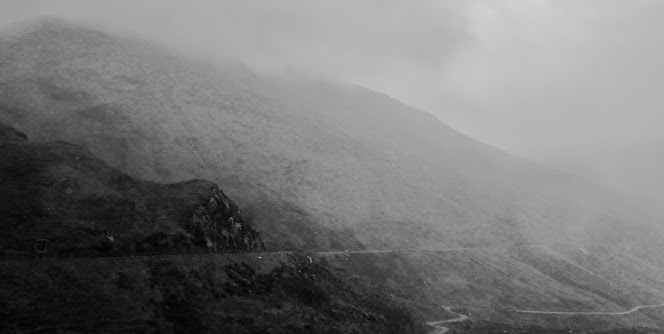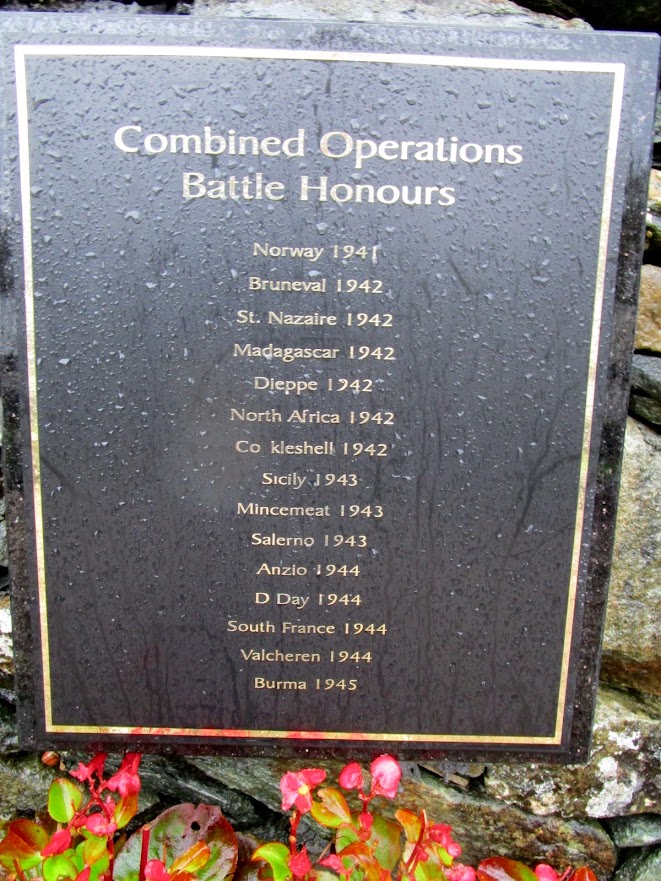I Think There is a Story in Here Somewhere
The Prep Work is Well Worth the Work
Inveraray, Scotland: Combined Ops training occurred 1 - 2 miles south
of the current town centre (which has not changed much since WWII).
Photo of a photo found in a restaurant on Inveraray's centre-most street
While preparing the video "FAINT FOOTSTEPS World War II" (Part 5) I realized that I assembled a great deal of material (i.e., useful, rare and significant photographs and links related to the script's core message), a goodly portion of which gets discarded at the end of the video-making process. I thought that while the material is still on my computer's desk top I would put it together as a post that reader's could refer to for more information about Canadians in Combined Operations. One or two photographs or links usually lead to more photos and links, which lead to more links and photos, and so on.
Hopefully, a few readers will find the background work as useful as the video itself. If so, it is because they have been willing to put in a bit of work as well. Cheers!
The script for video 5 follows with assorted photographs and links that could not all be used during the production:
Title - FAINT FOOTSTEPS, World War II (5)
Sub-Title - Good Training in Lovely Scotland
H14572. Troops charge ashore from landing craft during combined operations
training in the presence of the King at Inveraray in Scotland, 9 October 1941.
Photo - Capt. W.T. Lockeyear, Imperial War Museum (IWM)
(Readers can link to more photographs taken by Capt. W.T. Lockeyear, attributed to the IWM, and related to training aboard landing crafts at Inveraray).
Inveraray's centre-most street. Photo GH 2014
Photo - as found on restaurant wall, Inveraray, Main Street. GH 2014
Combined Operations training camp would be near top of the photo.
Loch Fyne possesses many isolated, shallow beaches, and beside them many large camps were built during WWII where sailors and soldiers could practice and master many necessary assault skills outside the range of German bombers.
Map in Combined Operations by C. Marks
"Loch Fyne possesses many isolated, shallow beaches"
Photos by GH, 2014; 1 - 2 miles south of Inveraray
Plastic plate from Combined Ops museum (now closed), Inveraray
Given to GH by Jim Jepson, Furnace, Scotland
The main goal of the largest establishment, i.e., Combined Operations No. 1 Training Centre (called H.M.S. Quebec, situated near Inveraray), was to train servicemen how to use various craft “for landing assault troops, supplies, ammunition and weaponry onto heavily defended enemy occupied beaches.”
"Various craft "for landing assault troops, supplies, ammunition..."
Photo A12054. LCT (2). Photo Credit - Lt. R.G.G. Coote
As found at Imperial War Museum, UK.
A12056. LCT (2), front view with ramp down.
Lt. R.G.G. Coote, IWM.
A12061. LCM (3). Lt. R.G.G. Coote, IWM.
A12063. LCM (3), front view with ramp down.
Lt. R.G.G. Coote, IWM.
H14597. Troops coming ashore from a landing craft under a smoke screen
during Combined Operations training at Inveraray, Scotland. "Mad Jack"
Churchill can be seen holding a sword. Capt. W.T. Lockeyear, IWM.
H.M.S Quebec, now a caravan or trailer park. GH 2014
More about the history of Combined Operations Command
can be found at www.combinedops.com by Geoff Slee
Modern traffic travels to Inveraray by a modern highway, the horizontal
line across the middle (approx.) of the photo above. "Jam-packed lorries"
took the low (and winding) road. Photos GH
The rain did not dampen my spirits while driving to Inveraray. GH
It was the busiest of camps, as well, and with the Dieppe Raid and invasion of North Africa only months away - unbeknownst to our raw recruits - a cadre of strict instructors wasted no time putting my father Doug Harrison and mates through their paces in small, flat-bottomed vessels that could run or slide up onto a shore in 8 inches of water when empty.
The caravan park is home to a significant memorial to those who served
in Combined Operations. Canadian connection - General James Wolfe
"Dieppe Raid and invasion of North Africa (were) only months away"
WW II 'drill hall' still stands, a few touches from 1940s remain
Brick walls and sturdy wooden doors stand the test of time
“We did much running up onto beaches,” my father Doug Harrison writes in memoirs, “so soldiers could disembark and re-embark, always watching the tide if it was flowing in or going out. You could be easily left high and dry, or broach too (i.e., turn sideways), if you weren’t constantly alert. We took long trips at night in close single formation, like ducks lined up close, because all you could see was the florescent waters churned up by propellors of an Assault Landing Craft up ahead, or Landing Craft Mechanized.”
Photo - Capt. W.T. Lockeyear, Imperial War Museum (IWM)
training by 29th Infantry Brigade Group at Loch Fyne, Argyllshire.
H11185 IWM. Major W. G. Horton, War Office official photographer
pool reserve and pier. A29894 IWM by Zimmerman, E A (Lt)
Join-up panorama of HMS QUEBEC, showing part of the training
pool reserve and pier. A29895 IWM by Zimmerman, E A (Lt)
The Canadian sailors transported so many different regiments and commando units on the lochs that there were too many to remember. Most of our boys, however, took to the new training and terminology related to different landing craft like the aforementioned ducks to water.
Port, starboard, fore, aft - got it. High, low, flood, ebb, neap tides - check. Kedges, winches, cables, anti-broaching lines - check. Breakfast 0600 - yipes!
H25389. Men of the 1st Battalion, Queen's Own Royal West Kent Regiment
wade ashore from landing craft during combined operations training in
Scotland, 17 November 1942. Photo - Capt. W.T. Lockeyear, IWM.
Photo H21363. Canadian troops in an assault landing craft (LCA) during a
combined operations exercise, July 1942. Photo Credit - Lts. Tanner
and Lockeyear, War Office Official Photographers, IWM.
Though many of the crafts used at H.M.S. Quebec - and later at Dieppe - were made almost solely of plywood, the good training did produce good results.
Canadians could clamber up and down scrambling nets and Jacob’s ladders very proficiently aboard the Ettrick, a liner anchored just offshore downtown Inveraray.
My father writes, “We got so it took about three seconds to drop 30 feet from the hand rails to the water line on the scrambling nets, because we learned to use only our hands”.
Hard work in beautiful surroundings toughened the sailors in memorable ways. The nearby hills caught many eyes and 30 years after the war’s end my father wrote, “I will always remember getting up in the morning to see the sun shining through the mist onto the purple heather. I made an excursion one day and actually rolled in it - to my delight.”
About that first trip to Scotland one could say, so far so good. So far.
Two Canadians from Effingham Division at HMS Quebec, 1942
Ray Ward (left) and Jim Cole, are seen together below as well.
Photo from the collection of Jim Spencer
Ray and Jim are together in the middle row, 2nd and 3rd from right
Jim Muirhead, on Ray's right side, is middle of back row below.
Joe Spencer is first on left, back row. Photo - Lloyd Evans, 1941
Scotty Wales, with pipe, first one on the left of the middle row above,
at HMS Quebec, 1942, appears first on the left in the front row in the
large group shot. Readers might spot one or two others in both pics.
Art Warrick, Hamilton, is seen here at HMS Quebec in 1942.
Art appears in the large group shot, 2nd from left, middle row.
From the collection of Joe Spencer
And in conclusion, we see two photographs taken from a rooftop at HMS Quebec during World War II.
A29892. General view of HMS QUEBEC, Inveraray, from the North.
RN Photographer Lt. E.A. Zimmerman, Imperial War Museum.
RN Photographer Lt. E.A. Zimmerman, Imperial War Museum.
The 5th video in the series entitled FAINT FOOTSTEPS World War II will soon follow.
Please click here to link to Video 4, Dark and Lonely Nights at Combined Ops Camp, 1942
Unattributed Photos GH




































No comments:
Post a Comment